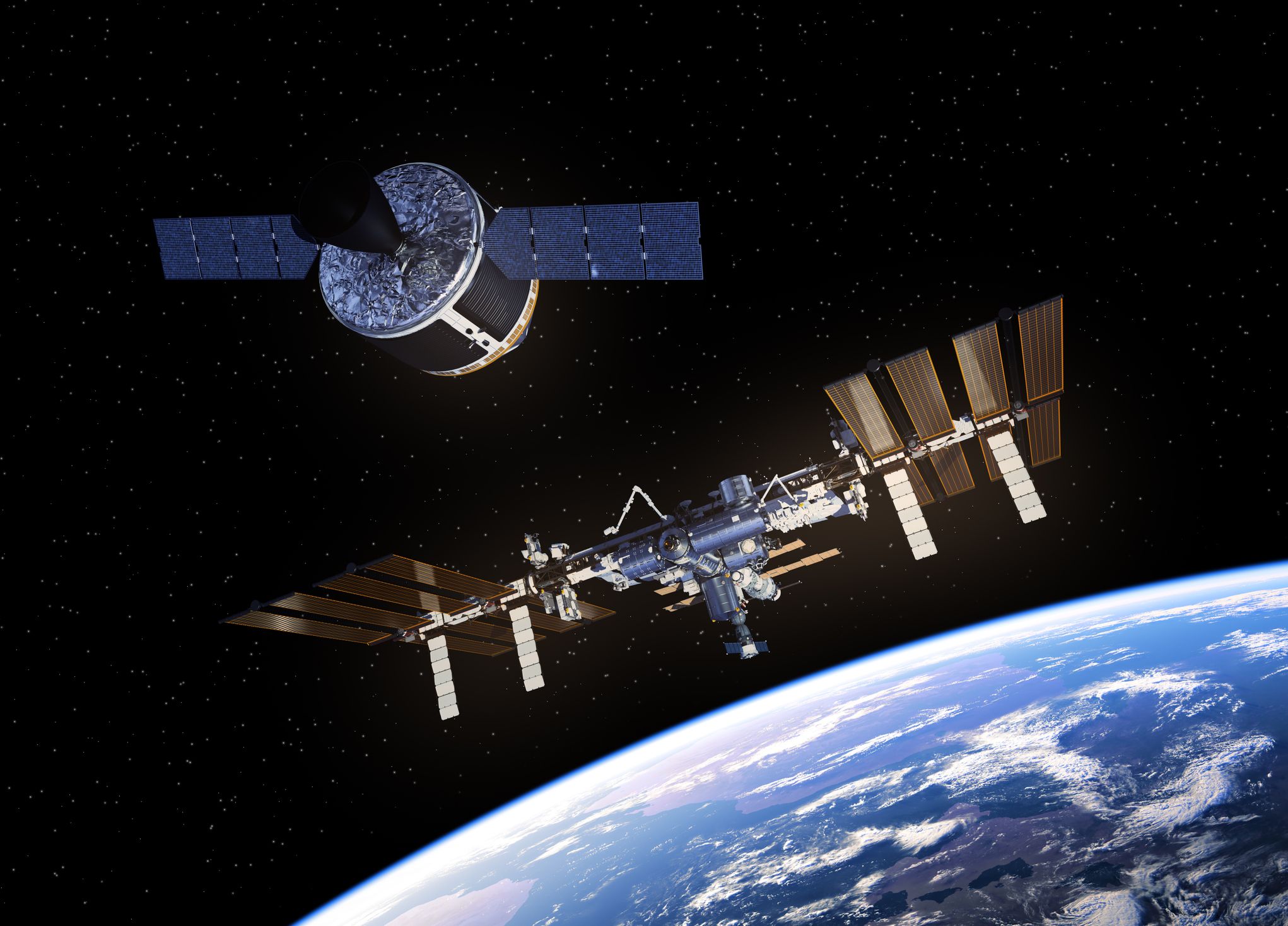If you watch sci-fi movies, you’d think that flying a spaceship is just like driving a slightly more complicated car (or a Winnebago in Spaceballs). And George Lucas gave us those galactic battles with pilots who look like they’re flying fighter jets on Earth.
Well, bad news: Space is really, really different. In particular, moving a vehicle in orbit around Earth is way more complicated than that. The maneuvers you might make with a plane sometimes have the opposite effect in orbit.
To see what I mean, we’ll first just grab some basic physics and build ourselves a little model of orbital mechanics, and then I have some cool simulations of an attempted docking maneuver. Read on!
Circular Orbits
Imagine flying in a circular orbit around Earth. There are three big physics ideas we need to understand this kind of motion. First, centripetal acceleration. Recall that acceleration is a measure of how fast the velocity of an object changes.
But velocity isn’t just speed, it’s speed in a particular direction—in other words, it’s a vector. If an object is moving in a circle, its direction is constantly changing, which means it’s constantly accelerating, even if its speed is constant!
The direction of this acceleration is toward the center of the circle. (“Centripetal” means center-pointing.) The magnitude of the acceleration depends on both the magnitude of the velocity (v)(i.e., the speed) and the radius (r) of the circle. This gives the following equation:

Courtesy of Rhett Allen
The next big idea is the gravitational force. There is an attractive force between any two objects with mass. This force decreases as 1 over the distance (r) between the objects, squared. Here’s how we calculate that:

Courtesy of Rhett Allen
In the equation above, M is the mass of Earth, and m is the mass of the orbiting object. (There’s a gravitational constant, G, in there too, but it isn’t important right now.) So what this says is that Earth’s gravitational pull declines rapidly as you move away from it.
The third big idea is the connection between forces and acceleration. This is Newton’s second law, which says the net force on an object equals the object’s mass multiplied by its acceleration.

Courtesy of Rhett Allen
Putting this all together, we see that the object’s mass is in both the force equation and Newton’s second law, so it will cancel. This gives us the following equation for our model, which is true for any object circling Earth, big or small.

Courtesy of Rhett Allen
Now we know how fast (v) an object has to move in order to be in a circular orbit of radius r. There’s no wiggle room here. If you start at some orbital distance and you aren’t going at that speed, you won’t be in a circular orbit.
Orbital Rendezvous
The best way to learn orbital mechanics is to jump into the pilot’s seat. Suppose you’re in a spacecraft circling Earth. Your orbit is the same as that of a space station, but you’re approaching from behind, and you have to catch up in order to dock.
What do you do? You have some rockets you can turn on, so the obvious answer is to fire your thrusters in the direction of travel to catch up. Well, that’s not gonna work. Here’s what happens:

Courtesy of Rhett Allen
See, the thrust increased the velocity of the spacecraft like we expected. But now the velocity doesn’t match the orbital radius, so it’s no longer in a circular orbit. Now it’s in an elliptical orbit.
I’ll tell you how to get back in a circular orbit, but let’s address the main problem. Notice that by increasing its speed, the small ship falls even farther behind the space station. Yes, it’s going faster, but at a greater distance from Earth. This means the length of its path is also greater.
Well, if speeding up doesn’t work, what about slowing down? Let’s try that. Here’s what happens if you fire the thrusters in the opposite direction:

Courtesy of Rhett Allen
Now your spacecraft is not going fast enough for that orbital distance. This moves it closer to Earth so that it travels a shorter distance than the space station—and passes it up! So, slowing down makes you go faster (from a certain point of view).
Hohmann Transfer
So how can we ever make our rendezvous? It requires a special move called the Hohmann transfer. This is a method of shifting from one orbital radius to another. Let’s forget about the space station for a minute and say you just want to get into a circular orbit closer to Earth.
We already did the first part of this, when the spacecraft fired its backward thrusters. This put us in an elliptical orbit with part of it being closer to Earth. Then you wait until you’re at the point of closest approach (the periapsis) and you slow down again, so that your speed now matches what’s required for a circular orbit at that radius. Check it out:

Courtesy of Rhett Allen
This move can be used for all types of orbital transfer. You want to go to Mars? You might think that’s like driving to Starbucks: point A to point B. Nope. What you’re really doing is moving from Earth’s orbit around the sun to the greater orbital distance for Mars. Interplanetary travel is basically the same thing as our space station rendezvous.
So now that you know how to pull off this move, you can use it to dock your spacecraft. You’re going to shift to a smaller radius to catch up to the space station (slow down to speed up), and at just the right moment, you’ll shift back to your original radius (speed up to slow down).
So, yeah, you kind of do have to be a rocket scientist to fly in space. Then again, sometimes driving a car on Earth is similar. In the Pixar movie Cars, when Doc Hudson says that in a hard curve you need to turn right to go left, Lightning McQueen mocks his advice as “opposite world.” Well, in some ways, orbital navigation really is opposite world!




